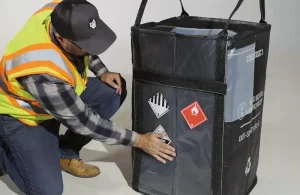 When it comes to handling hazardous materials, safety and compliance depend on much more than just choosing the right container. Every hazardous waste drum must be clearly labeled and properly marked to meet environmental, transportation, and workplace safety regulations. Whether it’s a 55 gallon hazmat drum, a chemical barrel, or a DOT approved hazmat container, accurate labeling ensures that everyone—from handlers to transporters—knows what’s inside and how to manage it safely.
When it comes to handling hazardous materials, safety and compliance depend on much more than just choosing the right container. Every hazardous waste drum must be clearly labeled and properly marked to meet environmental, transportation, and workplace safety regulations. Whether it’s a 55 gallon hazmat drum, a chemical barrel, or a DOT approved hazmat container, accurate labeling ensures that everyone—from handlers to transporters—knows what’s inside and how to manage it safely.
Understanding what information needs to appear on a drum can help facilities avoid costly fines and keep employees and the environment protected. Gorilla Drum provides compliant, high-quality hazmat storage drums that make proper labeling and handling easier for any operation.
Why Labeling and Marking Are Important
Hazardous materials can pose serious risks if not handled properly. Labels and markings serve as the first line of communication for anyone who comes into contact with the drum. They identify the type of waste, potential hazards, and handling requirements, helping to prevent accidents, spills, or improper disposal.
In addition to safety, labeling ensures compliance with regulations established by the U.S. Environmental Protection Agency (EPA), the Department of Transportation (DOT), and the Occupational Safety and Health Administration (OSHA). These agencies require clear and consistent labeling for all hazardous waste drums to ensure safe storage, transport, and disposal.
The Essential Information Every Hazardous Waste Drum Must Have
1. The Words “Hazardous Waste”
All containers holding hazardous materials must clearly display the words “Hazardous Waste.” This designation alerts workers, inspectors, and transporters that the contents are regulated and require special handling.
2. Accumulation Start Date
The date that waste is first placed into the container—known as the accumulation start date—must be marked on the drum. This helps track how long the waste has been stored, as most facilities are subject to time limits for how long they can hold hazardous waste on-site before shipping it to a treatment or disposal facility.
3. Description of the Waste
Each hazardous waste drum must include a clear description of its contents. This can include:
-
Chemical names or trade names
-
Hazard class or waste codes (such as EPA waste identification numbers)
-
Physical state (solid, liquid, or sludge)
The description ensures compatibility during storage and transport and prevents reactive substances from being stored too close to each other.
4. Generator Information
The drum must display the name, address, and contact details of the waste generator (the facility where the waste originated). This information ensures traceability and accountability throughout the waste management process.
5. DOT Markings and Labels
If the waste will be transported, DOT regulations require specific labels and markings to identify the hazard class of the material. These may include symbols for flammable, corrosive, toxic, or reactive materials.
For example:
-
Flammable liquid – Red label with a flame icon
-
Corrosive material – Black and white label with test tube graphic
-
Toxic substance – White label with skull and crossbones
These standardized symbols allow transporters and emergency responders to quickly recognize the risks associated with the container.
6. UN Identification Number
Each hazardous material has a unique four-digit UN identification number, which must appear on the drum. This number corresponds to the specific chemical or waste classification and is required by both DOT and international transport standards.
UN rated hazmat drums will also include a permanent UN certification mark that indicates the drum’s performance level, type of material it’s made from, and the maximum weight or pressure it can safely contain.
7. Handling Instructions and Warnings
In addition to regulatory markings, it’s good practice to include clear handling instructions such as:
-
“Do Not Overfill”
-
“Keep Upright”
-
“Use Proper PPE When Handling”
These visual cues reduce handling errors and ensure safe practices during loading, transport, and storage.
8. Condition Labels
If a drum is full, empty, or in need of inspection, it should be clearly labeled to indicate its status. Marking drums as “Full” or “Empty” helps avoid confusion and ensures that waste is managed in the correct order of accumulation.
Ensuring the Drum Itself Is Compliant
Labeling is only one part of the compliance equation—the container itself must also meet performance standards. The EPA, DOT, and UN require that all containers used for hazardous waste be properly tested, certified, and maintained.
Compliant hazmat storage drums and hazardous waste containers must be:
-
Compatible with the waste being stored
-
Structurally sound and free from leaks or corrosion
-
Properly closed and sealed when not in use
-
Clearly marked with manufacturer certification and UN rating codes
UN rated hazmat drums and DOT approved hazmat containers are designed to meet these requirements, ensuring safe containment and transport of regulated materials.
Best Practices for Chemical Drum Storage
Proper labeling and compliance also depend on how containers are used and maintained. When storing drums, facilities should:
-
Keep hazardous waste drums in a designated containment area away from non-hazardous materials
-
Use secondary containment like spill pallets to prevent environmental release
-
Inspect containers weekly for signs of leaks or deterioration
-
Ensure all labels remain legible and intact
Chemical drum storage should always follow safety guidelines to prevent accidents or contamination. Drums should be stored upright, secured from tipping, and protected from extreme temperatures or sunlight.
How to Choose the Right Drum for the Job
The correct container depends on the waste type, hazard level, and intended handling method. Choosing the wrong drum can lead to leaks, compliance issues, or unsafe working conditions.
To help make the right selection, review the Guide To Choosing The Right Hazmat Drums For Waste Storage. This resource provides insight into container types, material compatibility, and testing requirements to ensure safety and compliance for every waste stream.
Gorilla Drum: Safe, Efficient, and Compliant
Gorilla Drum provides an innovative alternative to traditional steel and plastic drums. Made from high-strength polypropylene, these collapsible containers are UN and DOT compliant, lightweight, and easy to handle. They’re ideal for managing hazardous liquids, solids, and mixed waste streams while maintaining full regulatory compliance.
Each Gorilla Drum features durable construction, leak-resistant closures, and labeling surfaces that make compliance easier. Whether you’re managing chemical waste or industrial byproducts, Gorilla Drum offers reliable containment solutions that simplify hazardous waste management.
Final Thoughts
A hazardous waste drum must have clear, accurate, and compliant labeling to ensure safety, regulatory compliance, and efficient handling. From the waste description and generator details to DOT markings and UN numbers, every label plays an essential role in preventing accidents and ensuring responsible waste management.
For safe, compliant, and cost-effective hazardous waste containment, Gorilla Drum delivers modern solutions that exceed traditional standards.
To learn more or request information about compliant waste drum solutions, call +1 800-758-8079.

